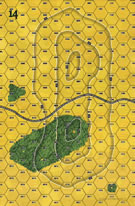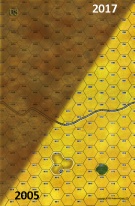|
Carving the Flank Little Saturn #2 |
||
|---|---|---|
| (Defender) Italy | vs | Soviet Union (Attacker) |
| Formations Involved | ||
|---|---|---|
| Italy |  |
37º Reggimento Fanteria "Ravenna" |
| Italy |  |
3ª Divisone Fanteria "Ravenna" |
| Italy |  |
90º Reggimento Fanteria "Cosseria" |
| Soviet Union |  |
58th Guards Rifle Division |

|
| Overall Rating, 4 votes |
|---|
|
3.5
|
| Scenario Rank: --- of 961 |
| Parent Game | Little Saturn |
|---|---|
| Historicity | Historical |
| Date | 1942-08-24 |
| Start Time | 09:15 |
| Turn Count | 25 |
| Visibility | Day |
| Counters | 114 |
| Net Morale | 0 |
| Net Initiative | 1 |
| Maps | 2: 14, 8 |
| Layout Dimensions | 86 x 28 cm 34 x 11 in |
| Play Bounty | 167 |
| AAR Bounty | 149 |
| Total Plays | 5 |
| Total AARs | 4 |
| Battle Types |
|---|
| Hill Control |
| Inflict Enemy Casualties |
| Conditions |
|---|
| Entrenchments |
| Off-board Artillery |
| Terrain Mods |
| Scenario Requirements & Playability | |
|---|---|
| Eastern Front | Maps + Counters |
| Fronte Russo | Counters |
| Little Saturn | Base Game |
| Road to Berlin | Maps |
| Introduction |
|---|
|
The Italians hastily erected a new and shorter defensive line hinged on Hill 217, a long crest line that shielded the two headquarters villages of Filonovo and Gadjuce (off the map, south of Board 14) from the enemy's view. This crest roughly coincided with the base of the Werch Mamon salient. This time the Soviet attack came from northwest. The company of the Ravenna Division holding the village of Krassno Orekowo (north of Board 8) was quickly forced out and the Soviets flooded eastward. |
| Conclusion |
|---|
|
It soon became clear that this time the Soviets were trying to gain control of Hill 217 and cut off Italian troops that had re-deployed and begun entrenching a mile to the north. The Italian defense fought bravely around a few strong points in the artillery positions. Thanks to the arrival of divisional reserves, the enemy attack was gradually halted. Reinforcements from the neighboring Cosseria Division swung the balance toward the Italians who then forced the Soviets attackers to withdraw. |
| Additional Notes |
|---|
|
The Italian major should be a Maggiore, the Italian captains should be Capitano. Artillery is from the Ravenna and Cosseria divisions, therefore upgrade 75/27 howitzers to 75/18 howitzers, as per special rule 16. |
| AFV Rules Pertaining to this Scenario's Order of Battle |
|---|
| 2 Errata Items | |
|---|---|

|
The reduced direct fire value in Kursk: Burning Tigers is 4-4. (plloyd1010
on 2015 Jul 31)
|

|
Kommissars never get morale or combat modifiers. Ignore misprints. (Shad
on 2010 Dec 15)
|
| Ataque al flanco | ||||||||||||
|---|---|---|---|---|---|---|---|---|---|---|---|---|
En este escenario un batallón de infantería italiana debe defender dos colinas ante el ataque de aproximadamente dos batallones de infantería soviéticos. Los italianos reciben el refuerzo de dos batallones adicionales a lo largo de la partida. Los italianos disponen de dos trincheras en una de las colinas. Ambos bandos tienen una moral parecida (7/5 los italianos y 7/6 los soviéticos). También ambos bandos disponen de las habituales unidades de apoyo (morteros, artillería ligera y una batería AT) y de artillería "off-board". Cada bando obtiene puntos de victoria (VP) por causar bajas al enemigo, por ocupar las trincheras y por ocupar hexes en los niveles 40 y 60 de la colina (en este último caso sólo para los soviéticos). Desde el primer momento los soviéticos se lanzan decididamente al ataque de las posiciones enemigas. Los italianos se ven abrumados por el asalto de la marea humana soviética y pierden algunas posiciones. No obstante, conservan el control de las dos trincheras. A partir del turno 12 entra una batallón italiano de refuerzo, que intenta reconquistar las posiciones perdidas en las colinas. La batalla llega entonces a un punto muerto, en que ambos bandos, muy debilitados, carecen de verdadero poder ofensivo. A partir del turno 19 entra como refuerzo un tercer batallón italiano. A la vista de ello los soviéticos deciden fortificarse en las posiciones conseguidas en las colinas y mantener una defensa a ultranza. Dada la premura de tiempo, los últimos refuerzos italianos entran y avanzan en camiones, lo que les convierte en blancos fáciles de los morteros y de la artillería soviética. No obstante, las unidades ilesas se apean de los camiones y asaltan las posiciones enemigas en la colina más próxima. El enérgico ataque italiano consigue eliminar algunas unidades enemigas, pero es incapaz de desalojar a todos los soviéticos de las posiciones que habían ocupado inicialmente. Al final se produce una victoria menor soviética por estrecho margen (28 VP de los soviéticos frente 21 VP de los italianos). Muy interesante y disputado escenario, en el que los italianos se han visto perjudicados por la tardía entrada de sus refuerzos. |
||||||||||||
| 0 Comments |
| Cota 217 | ||||||||||||
|---|---|---|---|---|---|---|---|---|---|---|---|---|
En este escenario una fuerza italiana compuesta inicialmente de algo menos de un batallón debe defender la cota 217 del ataque de dos batallones soviéticos. Los italianos deben defender también una pequeña colina situada al oeste de la cota 217. Los soviéticos atacan en masa desde el noroeste. La pequeña colina está indefensa y es ocupada rápidamente por los soviéticos, que además aniquilan fácilmente a una compañía reducida italiana que huía de la avalancha soviética. Se entabla una lucha violentísima por el control de la cota 217 y, en concreto, por dos posiciones atrincheradas que ocupan el centro de ésta. Los soviéticos van ganando terreno, pero en el turno 10 entra un batallón de refuerzo italiano por el sureste. Este batallón accede con mucha lentitud al centro del campo de batalla, lo que permite que entre tanto los soviéticos ocupen una posición atrincherada y asalten otra. Hacia el turno 15 entra un nuevo batallón italiano de refuerzo, ahora por el oeste. Su objetivo es ocupar la pequeña colina, que es defendida por cinco secciones de infantería soviética que han tenido tiempo suficiente para cavar pozos de tirador. Los italianos han tenido muchas bajas durante la primera mitad de la batalla. Ahora se permiten atacar desde este y oeste, pero la defensa soviética es correosa y apenas consiguen avanzar. Al final del turno 23 el comandante italiano se da por vencido. Resultado: los italianos consiguen apenas 7 VP frente a los 39 de los soviéticos. No obstante, la batalla ha sido más reñida de lo que estas cifras dan a entender. Victoria mayor soviética. Magnífico escenario. |
||||||||||||
| 0 Comments |
| Carving the Flank | ||||||||||||||
|---|---|---|---|---|---|---|---|---|---|---|---|---|---|---|
After 12 long years, we decided to get back into Panzer Grenadier. We first played Christnach, a Battle of the Bulge scenario to get us back on track and to get acquainted with the “new” 4th edition rules. Turned out that not much had changed. Now Christnach is a scenario with not much gaming going on, so we decided on a Little Saturn scenario. In this one, the Russians are trying to take the high ground with as much units as possible and then dig in to counter the incoming Italian reinforcements. I concocted a small house rule so that the Russian player had no idea where the reinforcements would come from and what faction they would be. The Italians placed their troops on hill 217, entrenching the artillery and awaited the onslaught. And so it began at around 9 AM of the 24th of August 1942 when remnants of the Ravenna Division skedaddled for their lives to the small hill south of Krosno Orekowo. They were just chased out of this hamlet by the1st Rifle Division and those Russians were in hot pursuit. But to the Italians surprise and obvious relief, the Russians suddenly turned eastward, straight at the crest of Hill 217. The entrenched artillery pieces had a field day disrupting the Russian lines of attack, and many units veered of to the north and south of the hill, trying to reach the wooded parts of this immense ridge. At noon, Italian reinforcements arrived from the south, splitting up into 2 groups. One group to help the trenches and the other to clear out the woods on the easternmost hill section. The Russians however quickly adapted to this new development and after dispatching all Italian troops from the small hill, started to assault the trenches in earnest. Those trenches turned out to be a damned hard nut to crack. The Russian attacks faltered time after time and they certainly weren’t helped when the Russian major as well as the Kommisar were fatally wounded. The decapitation lasted for the best part of half an hour before order was restored. But under this new leadership, the attacks gained in vigor and the first trench was overrun. At the same time, a large amount of Italian troops surged on the battlefield from the west. But, could they make it in time? They were still miles away from the fighting and time was running out. These new troops cut their way through the small defending contingent on the western hill but these skirmishes kept the reinforcement units from reaching the besieged trenches. And when the Italians were halted and contained in the wooded hill area, the battlefield suddenly turned eerily quiet. Both sides licked their wounds and decided that further assaults would prove to be too late or too risky. And as such it was VP counting time: Russians: 18 steps killed, 1 trench in Russian hands and 12 units on the hill: 33 points Italians: 32 steps killed, 2 trenches in their possession : 38 points A draw! This result was celebrated by the Russian player as a victory against all odds and to the Italians it felt as a defeat that could have been prevented. This game turned out to be a fire cracker of a scenario, with both sides having to attack and defend at the same time. Great stuff, and just the thing that we needed to get us hooked on this wonderful system once again. |
||||||||||||||
| 1 Comment |
| Up the hills only to get crunched! | ||||||||||||
|---|---|---|---|---|---|---|---|---|---|---|---|---|
The Italians set up on the 40 meter line of the hills and the Russians (having no other option) slammed right into it. It was nip and tuck until the last set of Italian reinforcements came in on turn 15 and sealed the Russian's fate. Called the game on turn 18. (Note - This one could have been done better as far as the assault went. Best played solo by a Commander who wants to sharpen his offensive tactics against overwhelming odds.) |
||||||||||||
| 0 Comments |

 LiSa001
LiSa001 
























